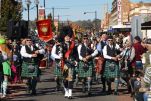Mining or Mountain?
Choose to explore the fascinating mining or mountain villages of Glen Innes Highlands and be transported back in time.
Our three mining villages of Emmaville, Torrington and Deepwater have richly contrasting landscapes immersed in the history of the mining boom days. Tour Drive 11 is a 140km round-trip that traverses rolling New England pastures, majestic trees, and the mining country of our famous Reddestone sapphires.
Tour Drive 2 takes you on a journey through the mountain village of Glencoe to Ben Lomond. This route is particularly popular during autumn, as the tree-lined roads are ablaze with seasonal colour. Explore the towering granite boulders and parklands at Stonehenge Recreation Park and ponder gravity as you view the famous Balancing Rock.







Emmaville
Emmaville boomed after the discovery of tin in the local creek in 1872 and was initially named Vegetable Creek after the Chinese market gardens that were planted to feed the settlement.
By the early 1900s, the mining town’s population swelled to 7,000, including 2,000 Chinese, with 5 hotels, a joss house, a school, postal services and a hospital. Australia’s first medical benefits fund and St John’s Ambulance service both began in Emmaville.
Today the town is home to a proud community of about 300 people. Take time to explore the streets and many of the original public buildings, miner's cottages and the cemetery. Enjoy a counter meal or drink and have a chat with the locals in one of the town’s original hotels.
Visit the Emmaville Mining Museum for a real glimpse into the local history - it's an absolute gem of an experience, with extensive collections of gems and minerals on show, as well as hundreds of old mining photographs, military memorabilia and displays, original old bakery and general store, a machinery display, bottle collection, and more!
Glencoe
The picturesque village of Glencoe is located 22km south of Glen Innes. Glencoe was named by early European settlers after Glencoe, Scotland.
The small farming village has an elevation of 1,150 metres and a population of approximately 200.
The Glencoe Sports ground is located on the northern side of the village and is a great spot for birdwatching.
Located north of Glencoe is Balancing Rock and Stonehenge Recreational Reserve - both great places to relax for a picnic.










Deepwater
Deepwater is located 35km North of Glen Innes on the New England Highway. The village was established in 1838 and is home to a thriving community of about 400 people, many of which are directly related to the original settler families.
With the opening of the Great Northern Railway Line in 1886, Deepwater became a bustling township exporting wool, dairy, livestock, meat and mining products. Today you will find historic buildings still in existence, including the Picture Theatre, Court House, Post Office, School of Arts, Deepwater Public School, General Store, and Railway Station.
The area is largely agriculturally focused, with the main pursuits being wool, fat lambs and beef cattle production. In January, the town comes alive with over 3,000 people visiting for the annual Deepwater Races. While in town, enjoy a meal or refreshment. There is also a great antique store located on the main street. Other popular activities include fishing, camping along the beautiful river frontage, and farm stays that offer visitors the chance to experience farm life first-hand.
Dundee
The little hamlet of Dundee is located between the village of Deepwater and the township of Glen Innes.
Dundee is the gateway to Rangers Valley Feedlot. It's home to the district's first flour mill and the Severn River Rail Bridge – the longest timber truss bridge in Australia.
Surrounded by grazing and farming properties, Dundee holds an annual Campdraft, which is a fun family event. Visit the historic cemetery with magnificent wrought iron gates and enjoy a drive through scenic countryside.









Torrington
The discovery of the extremely rich Torrington tin lode in 1881 created much excitement, but in a very short time the small prospectors had lost control to overseas mining companies, the precursors of today's multi-nationals.
In the 1920s, 500 men were employed at the mines here. Mining has given way to fossicking and tourism and now visitors enjoy the spectacular scenery of rocky granite outcrops, steep gorges, gently flowing streams, and fossicking for topaz, quartz and other minerals found in the area.
Torrington State Recreation Area covers 30,000 hectares of wilderness, featuring the famous Mystery Face Rock, Thunderbolt's Lookout and many other spectacular rock formations, streams, waterfalls, flora and fauna. The reserve is recognised as being of State significance for conservation, mining, honey production, recreation and cultural heritage.
-
Partner with us
- Add your business
- Use of GIH logo
-
Related Sites
- Glen Innes Severn Council
- Glen Innes Highlands Hub
Acknowledgement of Country
Glen Innes Highlands acknowledges and pays respect to the Ngarabul people as the traditional custodians of this land, their elders past, present and emerging, and to Torres Strait Islander people and all First Nations people.
Terms & Conditions | Privacy | Disclaimer
2025 © All Rights Reserved. Website designed by gocrossmedia and built by Cloud Concepts









